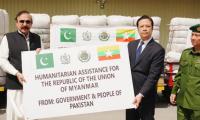Pakistan is fortunate to have a leader like Imran Khan who is honest and sincerely committed to the process of equitable socioeconomic development. This opportunity to turn around the nation has presented itself after decades of loot and plunder by greedy and corrupt leaders who have brought the country to its knees.
However, seeking any gains under our system of governance, run by ‘electables’ who lack competence in their respective fields, is akin to trying to win a cricket match with a volleyball team. That’s why I have been advocating a technocrat government under a presidential system of democracy, as envisioned by Quaid-e-Azam Mohammed Ali Jinnah.
In order for Pakistan to emerge from its present crisis of poverty, hunger, deprivation, joblessness and foreign debt, it needs to shift towards a knowledge economy. About 100 million people are below the age of 25, which is about 56 percent of our population.
If we are to develop a knowledge economy, it must be done by unleashing the huge creative potential that lies hidden in these young men and women. The release of this potential can only be achieved by investing in a high-quality education system and linking the process of education with the process of socioeconomic development. This will allow us to prepare the required number of technically-qualified professionals in areas of national needs and utilise them in national projects geared towards achieving self-reliance and enhancing exports, particularly of high-technology products.
The incumbent government needs to use CPEC as the launching pad to establish high value-added industries, ranging from electronics to engineering goods, from pharmaceuticals to automobiles, and from focusing on shipbuilding to creating new and intelligent materials.
Simultaneously, we need to invest in our technical training institutions and universities, with a particular focus on training a sufficient number (about 100,000) of our brightest youth in top institutions abroad. These young people can later serve as teachers so that we can adequately prepare our youth for the world of today and tomorrow. China is sending six million students abroad each year for PhD and postdoctoral training. We need to send at least 20,000 each year along similar lines.
In order to transition from a low value-added agricultural economy to a knowledge economy, three major players need to come together: universities, industry and the government. Universities need to prepare the human talent needed in each sector, and set up technology parks and business incubators to provide opportunities to young entrepreneurs to establish new start-up companies.
The facilities that should be freely available within such technology parks include legal and financial services and professional management advisers. The government will be required to make the needed investments to improve university standards of teaching and research. Centres of excellence in selected fields will need to be established with good foreign partners.
Technology parks should be established in every university. Venture capital should be made available for new start-ups to facilitate the creation of new high-technology industries. Tax incentives must be offered to new technology-based industries. This will result in the manufacture and export of high-technology goods that should become the cornerstone of national policies and development plans.
The private industrial sector has a critical role to play in this effort to set up a knowledge economy. This is borne out by the fact the global share of the private sector’s R&D has been rising much faster than the government’s R&D, particularly in rapidly developing countries like Korea, Singapore, and Taiwan.
During 2018, the total R&D expenditure is estimated to be about $1.6 trillion, of which businesses contribute about 62 percent while the governments contribute only 38 percent. The private sector’s R&D amounts to about 70 percent of the total R&D expenditure in China, 75 percent in Korea and Japan, 70 percent in Germany and 68 percent in the US.
The private sector’s R&D in Pakistan and most other OIC member states, by contrast, is less than one percent. This disparity between the West and OIC member states is also reflected in the availability of trained scientific manpower. There are 10,563 scientists and engineers per million population (pmp) in Finland, 9,222 in Norway, 8,846 in Denmark and an average of 4,481 in EU countries.
However, there are only an average of 451 scientists and engineers in OIC member countries and about 300 scientists and engineers pmp in Pakistan. This highlights how far we have fallen behind. Pakistan has done little or nothing to stimulate the private sector’s R&D by offering tax incentives, grants to promote innovation and train manpower, subsidies to establish high-tech industries; and establishing bridging institutions, such as technology parks and incubators.
In order to gain a competitive edge, countries such as Korea, Japan, Singapore, and Taiwan have focused on selected industries, such as automobiles, engineering goods, shipbuilding, electronics and computer manufacturing. Various governments stimulated the development of these industries by giving incentives, and helping companies to develop capabilities in design and engineering.
To help private industries enhance their capabilities, semi-government bridging institutions were established, including engineering centres, technology parks, industrial parks, and incubation centres. Incentives were also granted to establish links with diaspora communities abroad that also contributed to the transfer of cutting-edge technologies. In Pakistan, we have been oblivious to such initiatives.
In 2004, the then cabinet decided that the ‘Technology-based Industrial Vision and Strategy for Pakistan’s Socio-Economic Development’ should be carried out under my leadership. This would set a clear national path to determine how far the country could progress. Over the next two years, an intensive exercise was carried out to determine the roadmap within 13 key sectors, including agriculture, engineering, information technology, telecommunications, electronics, chemicals, pharmaceuticals and textiles.
This involved detailed consultations within each sector among subject experts, industrialists and specialists among our diaspora abroad and officials of the relevant ministries of the provincial and federal governments.
As a result, a 320-page document was prepared that clearly sets out what Pakistan must do over the next 15 years, broken into three five-year periods, the cost of each project, and the impact on the national economy and the process of social development. This 15-year industrial vision, strategy and action plan was approved by the cabinet in August 2007 and an inter-ministerial committee was constituted for its implementation. I presented it to the prime minister on August 31, 2018. I can only hope that it is taken up seriously for implementation.
The initial 90 days of the present government are over and we now need to seriously look ahead, with a focus on training our youth for the world of tomorrow.
The writer is the former chairman of the HEC, and president of the Network of Academies of Science of OICCountries (NASIC).
Email: ibne_sina@hotmail.com
This demand has fueled rapid growth deposit base of Islamic Banks and Islamic Windows operated by conventional banks
But Punjab Agriculture Food and Drug Authority building near Thokar Niazbeg on Multan Road stands out
Macron has been particularly vocal in their criticism, asserting that withholding arms from Kyiv plays directly into...
As PPP governs province, Bilawal Bhutto Zardari holds strategic position to address both violence and its underlying...
Critics argue that strategy is vague, but closer look indicates strategic alignment with global trends and national...
To defeat it, we must distrust bot-driven narratives, to defeat it, we must verify sources before believing or sharing







